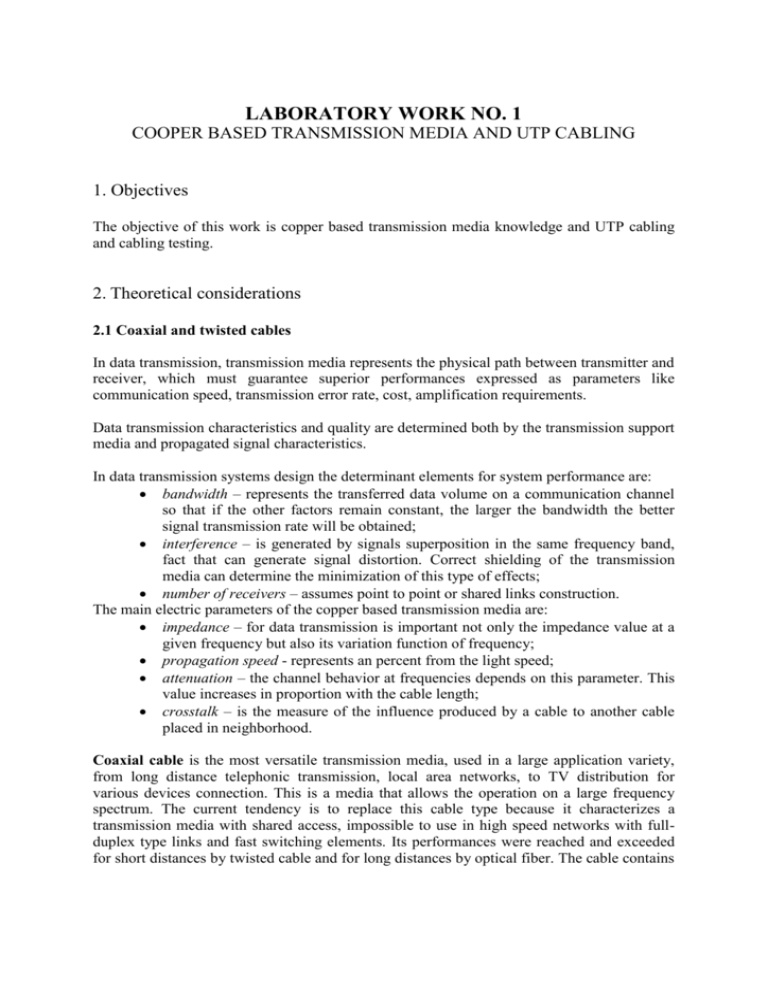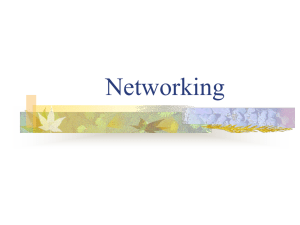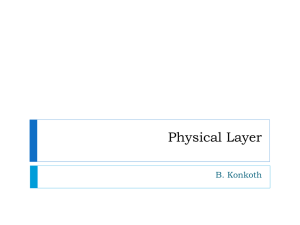Cablaj
advertisement

LABORATORY WORK NO. 1 COOPER BASED TRANSMISSION MEDIA AND UTP CABLING 1. Objectives The objective of this work is copper based transmission media knowledge and UTP cabling and cabling testing. 2. Theoretical considerations 2.1 Coaxial and twisted cables In data transmission, transmission media represents the physical path between transmitter and receiver, which must guarantee superior performances expressed as parameters like communication speed, transmission error rate, cost, amplification requirements. Data transmission characteristics and quality are determined both by the transmission support media and propagated signal characteristics. In data transmission systems design the determinant elements for system performance are: bandwidth – represents the transferred data volume on a communication channel so that if the other factors remain constant, the larger the bandwidth the better signal transmission rate will be obtained; interference – is generated by signals superposition in the same frequency band, fact that can generate signal distortion. Correct shielding of the transmission media can determine the minimization of this type of effects; number of receivers – assumes point to point or shared links construction. The main electric parameters of the copper based transmission media are: impedance – for data transmission is important not only the impedance value at a given frequency but also its variation function of frequency; propagation speed - represents an percent from the light speed; attenuation – the channel behavior at frequencies depends on this parameter. This value increases in proportion with the cable length; crosstalk – is the measure of the influence produced by a cable to another cable placed in neighborhood. Coaxial cable is the most versatile transmission media, used in a large application variety, from long distance telephonic transmission, local area networks, to TV distribution for various devices connection. This is a media that allows the operation on a large frequency spectrum. The current tendency is to replace this cable type because it characterizes a transmission media with shared access, impossible to use in high speed networks with fullduplex type links and fast switching elements. Its performances were reached and exceeded for short distances by twisted cable and for long distances by optical fiber. The cable contains COMPUTER NETWORKS a copper core insulated from the second exterior conductor, made as a shield from a thin wire braid. The main characteristics of the coaxial cable are: allows digital and analog signal transmission; because of concentric construction type, is resistant to magnetic interference. The main constraints related to performances refer to its attenuation, inter-modular noises and heating. Coaxial cable used in local area networks has 50 Ohms impedance and is of 2 types: thin coaxial cable (RG58 in 10BASE2 type IEEE 802.3 networks) is the most wide-spread and used for interior installations because of a good price/performance ratio; thick coaxial cable (RG213 in 10BASE5 type IEEE 802.3 networks) is used for exterior installations because of a higher mechanical resistance and a better length limit. Computers connection to coaxial cable is done using two methods: using T junctions or special connectors called vampire connector placed into a device called transceiver, which allow their thrust in cable without its cutting necessity. The connector penetrates the insulator layer making the contact directly with the conductor layer. The connection between transceiver and network interface card is done with a transceiver cable that is connected to AUI port (Attachment Unit Interface). For long distances analog transmission, signal amplifiers are required, and for digital signals, repeaters are required, the standards specifying exactly their placement distance. In thin coaxial cable case, the maximum distance is 185m and in thick coaxial cable case, the maximum distance is 500m. Twisted cable (twisted pair - TP) or cable with twisted pairs of copper wires, having a common outer jacket (with or without shielding), represents the usual cable type used in local area networks and telephone system. The purpose of wire twisting is the reduction of magnetic distortion, of interferences between adjacent pairs of cable. This cable acts like a single communication link. For cables with several twisted wire pairs, twisting steps must be different for each pair so that the crosstalk between pairs to be minimum. Because of the progress realized in TP cable manufacturing technology, these can be used in a very large frequency range allowing data transmissions up to 125 Mbps, and in Gigabit networks offering for short distances performances comparable with optical fiber. TP cable represents the transmission media for analog and digital signals usually used in telephone system and local area networks. There are three types of TP cables used in computer networks, each having four twisted wire pairs and allowing a maximum 100m distance: STP shielded cables (Shielded Twisted Pair), which have shielding for each pair of wires and for entire cable. These cables have 150 Ohms impedance, being used in 10 and 100Mbps speed networks; ScTP cables (Screened UTP) or FTP (Foiled Twisted Pair) which have only shielding for entire cable. These cables have 100 or 120 Ohms impedance, being used in 10 and 100Mbps speed networks; 2 COOPER BASED TRANSMISSION MEDIA AND UTP CABLING UTP unshielded cables (Unshielded Twisted Pair) which don’t have shielding. Is the most used cable type and have 100 Ohms impedance, being used in 10, 100 and 1000Mbps speed networks. Twisted cables categories used in data transmissions are differentiated function of supported utilizations: Category 1 – designates the cables for classical analogical telephony; Category 2 – describes the cables for digital and analogical telephony, but which does not offer data transmitting services at superior speeds; Category 3 – cables that can be used for usual speed LAN-s, Ethernet 802.3 type, with speeds up to 16Mbps and Token Ring networks at 4Mbps; Category 4 – defines cables with high performances, having transmission characteristics that exceed 20Mbps; Category 5 – describes cables suitable for Fast Ethernet networks at 100Mbps speed. This cable category is frequently used in cabling, because it offers high performances; Category 5e – describes cables suitable for Gigabit Ethernet networks at 1Gbps speed. This cable category is also frequently used in cabling, because it offers high performances; Category 6 – allows data transmission up to 155Mbps; Category 7 – allows data transmission up to 1Gbps. All these classifications do not refer only cables but also the entire associated connecting system: connectors, outlets, patch panels etc. Twisted cable allows point to point connection implementations, realizing different star or extended star type network topologies. This fact offers special performances comparing with bus type topology, made mostly using coaxial cable. 2.2 UTP cabling At Ethernet and Fast Ethernet networks UTP cabling 1-2 wire pair is used for transmission and 3-6 pair for reception. This wire type arrangement is called MDI (Media Dependent Interface) or normal arrangement (straight cable). Usually the wires are connected according to the same rule in the connectors at the two ends of the cable, case in which the cable (patch cord) is called straight-through. In some special cases the reception must be reversed with transmission in order to enable communication, case in which the cable (patch cord) is called crossover. At Gigabit Ethernet networks UTP cabling all four wire pairs are used both for transmission and reception. UTP cables contain four twisted wire pairs each pair being identified through a color: blue, orange, green and brown. Each pair contains a colored wire and a white combined with the respective color wire. The connectors used for this cable are RJ-45 type male connectors containing 8 pins corresponding to the 8 wires. Viewed from the front, the pins are numbered from 1 at right to 8 at left. The wire connection mode to the pins determines the cable type. There are two standards for wire connection to RJ-45 connector: EIA/TIA-T568-A and EIA/TIA-T568-B. These connections are presented below. 3 COMPUTER NETWORKS Table 1.1 EIA/TIA-T568-A Pin# Pair# Function Wire color 1 2 3 4 5 6 7 8 White/Green Green White/Orange Blue White/Blue Orange White/Brown Brown 3 3 2 1 1 2 4 4 Transmission+ TransmissionReception+ Not used Not used ReceptionNot used Not used Used with Used with 10/100BASE-T 100BASE-T4 and 1000 BASE-TX Yes Yes Yes Yes Yes Yes No Yes No Yes Yes Yes No Yes No Yes Table 1.2 EIA/TIA-T568-B Pin# Pair# Function Wire color 1 2 3 4 5 6 7 8 White/Orange Orange White/Green Blue White/Blue Green White/Brown Brown 2 2 3 1 1 3 4 4 Transmission+ TransmissionReception+ Not used Not used ReceptionNot used Not used Used with Used with 10/100BASE-T 100BASE-T4 and 1000 BASE-TX Yes Yes Yes Yes Yes Yes No Yes No Yes Yes Yes No Yes No Yes So, in order to obtain a straight-through cable both ends of the cable must be connected according to the same standard and in order to obtain a crossover cable each end of the cable must be connected according to a different standard. At UTP cabling are used both passive and active devices. Passive devices are not supplied from a voltage source while active devices require power supply. The most important passive devices are: RJ-45 jack, outlet and patch panel. At layer 1, the most important active devices are the hub and the transceiver. An RJ-45 jack is a device with eight conductors in which is connected the RJ-45 connector. This enters in outlets and patch panels structure. In outlets are connected the computers using patch cords. The outlets are connected to the patch panel which is located in the distribution closet. Using a patch cord, the patch panel is connected to the hub which is also located in the distribution closet. The hub is a multiport repeater. The transceiver is a bidirectional device which receives the signals from one type of interface, converts them in specific signals for another type of interface and transmits them to an interface of that type. 4 COOPER BASED TRANSMISSION MEDIA AND UTP CABLING 3. Lab activity 3.1 UTP cables connection and testing Several straight-through cables will be made and tested. Several crossover cables will be made and tested. 3.2 Networks cabling and testing The connectivity between two computers will be tested using a crossover cable. Cable and test the connectivity of the network presented in figure 1.1. Host Outlet Host Outlet Host Outlet Patch panel Figure 1.1 Cabling test network 5 Hub








